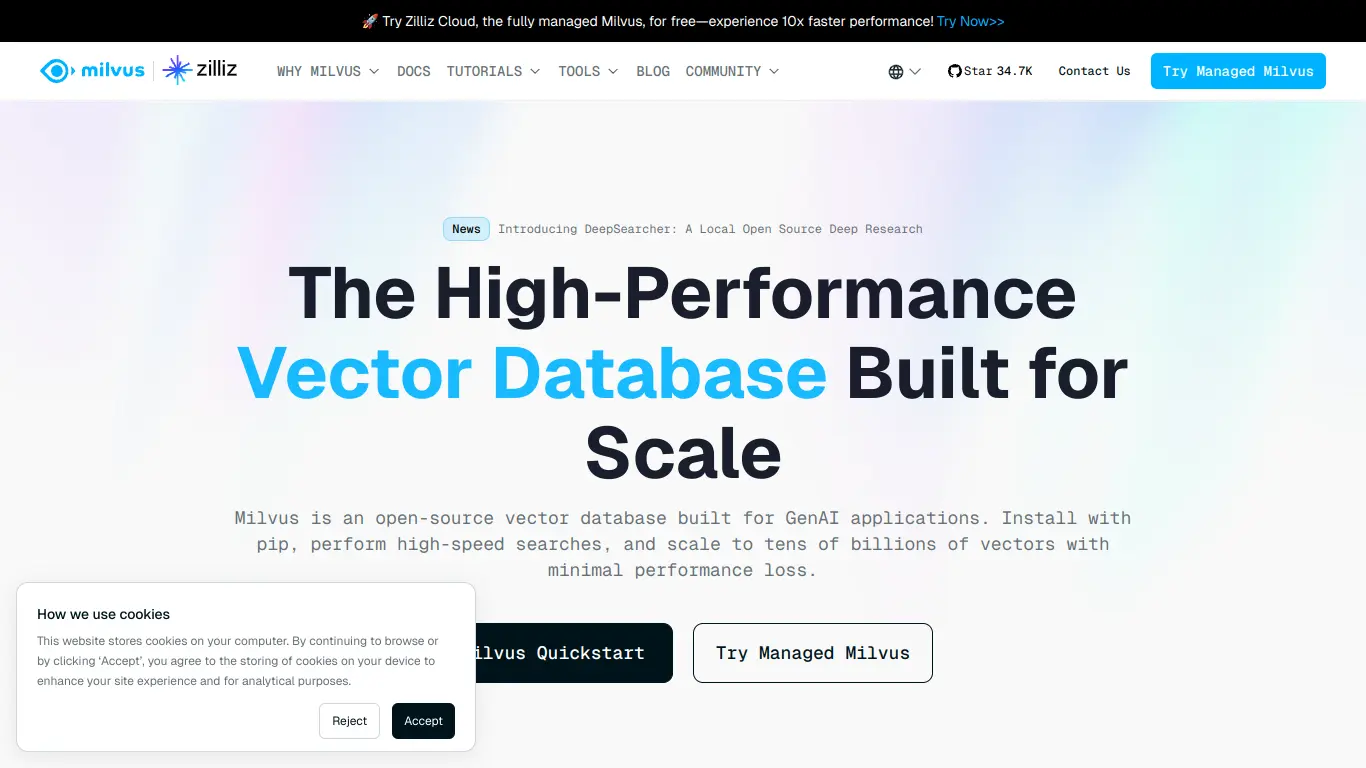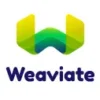Milvus is an open-source vector database designed for embedding similarity search, powering AI applications with scalable, high-performance queries.
Introduction to Milvus
Organizations face the growing challenge of managing and retrieving information efficiently from massive vector datasets. If you’ve been struggling with vector similarity search for AI applications, you’re not alone. Traditional databases simply weren’t designed to handle the complexities of vector data, leading to slow performance, scaling issues, and maintenance headaches. This is where Milvus enters the picture.
What is Milvus and its Purpose?
Milvus is an open-source vector database built specifically for embedding similarity search and AI applications. It’s designed to help developers and data scientists efficiently store, index, and query large-scale vector data with blazing-fast performance.
At its core, Milvus solves the fundamental problem of finding similar items in high-dimensional space—a critical requirement for modern AI applications like image recognition, natural language processing, recommendation systems, and other machine learning workloads that rely on embedding vectors.
As AI continues to transform industries, Milvus provides the infrastructure needed to operate production-ready, similarity search applications at scale. It bridges the gap between raw vector data and actionable insights by making vector similarity search accessible, reliable, and incredibly fast.
Who is Milvus Designed For?
Milvus caters to a diverse range of technical professionals who need powerful vector similarity search capabilities:
- Data Scientists and ML Engineers: Those working with embeddings from language models, computer vision systems, or recommendation engines
- AI Application Developers: Teams building search applications, recommendation systems, or other AI-powered tools
- Database Administrators: Professionals seeking to add vector search capabilities to their data infrastructure
- Research Scientists: Individuals exploring large datasets and requiring similarity-based retrieval
- Enterprise IT Teams: Organizations that need to scale AI applications with reliable, production-grade infrastructure
Whether you’re a startup building your first AI feature or an enterprise deploying large-scale machine learning systems, Milvus provides the tools to handle your vector data efficiently.
Getting Started with Milvus: How to Use It
Getting up and running with Milvus is straightforward, even for those new to vector databases. Here’s a quick overview of how to start:
- Installation: Milvus offers multiple deployment options:
- Docker (recommended for most users)
- Kubernetes with Helm charts (for production environments)
- Build from source (for advanced customization)
- Creating a Collection: Collections in Milvus are similar to tables in traditional databases. Define your schema with fields and vector dimensions.
from pymilvus import Collection, FieldSchema, CollectionSchema, DataType
# Define fields
fields = [
FieldSchema(name="id", dtype=DataType.INT64, is_primary=True),
FieldSchema(name="vector", dtype=DataType.FLOAT_VECTOR, dim=128)
]
# Create collection
schema = CollectionSchema(fields)
collection = Collection(name="example_collection", schema=schema)
- Inserting Data: Upload your vector embeddings along with metadata.
import random
import numpy as np
# Generate sample data
entities = [
[i for i in range(2000)], # IDs
np.random.random((2000, 128)).tolist() # 2000 vectors of dimension 128
]
# Insert data
collection.insert(entities)
- Building an Index: Create an index to speed up searches.
index_params = {
"index_type": "IVF_FLAT",
"metric_type": "L2",
"params": {"nlist": 128}
}
collection.create_index("vector", index_params)
- Performing Searches: Query for similar vectors with customizable parameters.
# Search parameters
search_params = {"metric_type": "L2", "params": {"nprobe": 10}}
# Search for the 5 nearest vectors
results = collection.search(
data=[np.random.random(128).tolist()], # Query vector
anns_field="vector",
param=search_params,
limit=5
)
Milvus also provides client SDKs for multiple programming languages including Python, Java, Go, and Node.js, making it accessible to developers regardless of their preferred tech stack.
Milvus’s Key Features and Benefits
Core Functionalities of Milvus
Milvus comes packed with powerful features designed to handle the unique challenges of vector data management:
1. High-Performance Vector Search
- Support for multiple similarity metrics (Euclidean, Inner Product, Cosine, etc.)
- Various indexing types optimized for different workloads (HNSW, IVF, FLAT, etc.)
- GPU acceleration for faster searches on compatible hardware
2. Scalable Architecture
- Cloud-native design with separate components that can scale independently
- Support for distributed deployments across multiple nodes
- Ability to handle billions of vectors with consistent performance
3. Advanced Data Management
- Schema-based data organization with support for vector and scalar fields
- ACID-compliant transactions for data consistency
- Time Travel (data versioning) for point-in-time recovery
4. Comprehensive Query Capabilities
- Approximate Nearest Neighbor (ANN) search for similar vectors
- Boolean expressions and filtering on scalar fields
- Hybrid search combining vector similarity with attribute filtering
5. Robust Persistence and Reliability
- Write-ahead logging for data durability
- Snapshot and backup mechanisms
- High availability options for production deployments
6. Enterprise Security Features
- Role-based access control
- Data encryption
- Audit logging
Advantages of Using Milvus
By adopting Milvus for your vector search needs, you gain several significant advantages:
⚡ Exceptional Performance
Milvus is optimized specifically for vector operations, delivering searches that are orders of magnitude faster than general-purpose databases. In benchmark tests, it can perform ANN searches across millions of vectors in milliseconds.
🔍 Search Accuracy
The platform offers fine-grained control over the speed-accuracy tradeoff, allowing you to choose the perfect balance for your specific use case.
⚖️ Flexible Scaling Options
Unlike monolithic databases, Milvus allows horizontal scaling of specific components based on your workload patterns. This means you can add more query nodes for read-heavy workloads or more data nodes for storage-intensive applications.
🔄 Seamless Integration
With support for popular AI frameworks and multiple client SDKs, Milvus fits easily into existing data pipelines and application architectures.
💸 Cost Efficiency
As an open-source solution, Milvus eliminates licensing costs while reducing infrastructure expenses through its efficient resource utilization.
🛠️ Active Community
Being open-source and backed by a thriving community means rapid development, regular updates, and a wealth of resources for troubleshooting and optimization.
Main Use Cases and Applications
Milvus powers a wide range of AI applications across industries:
Image and Video Analysis
- Reverse image search engines
- Content-based image retrieval
- Video deduplication and analysis
- Face recognition systems
Natural Language Processing
- Semantic text search
- Document similarity analysis
- Question-answering systems
- Chatbot knowledge bases
Recommendation Systems
- Product recommendations in e-commerce
- Content recommendation for media platforms
- Similar item discovery
- Personalized search experiences
Scientific Research
- Drug discovery through molecular similarity
- Genomic sequence matching
- Astronomical data analysis
- Material science research
Financial Services
- Fraud detection systems
- Risk assessment models
- Market trend analysis
- Algorithmic trading strategies
Healthcare
- Medical image analysis
- Patient similarity for treatment recommendations
- Drug interaction prediction
- Disease pattern recognition
The versatility of Milvus makes it valuable in virtually any field where finding similarities in complex data is important—from cybersecurity and IoT to manufacturing and logistics.
Exploring Milvus’s Platform and Interface
User Interface and User Experience
Milvus prioritizes developer experience while maintaining powerful functionality. The platform offers multiple interfaces to interact with your data:
Command Line Interface (CLI)
For those who prefer terminal-based interactions, Milvus provides a comprehensive CLI tool that covers all essential operations:
$ milvus-cli
milvus_cli > connect -h localhost -p 19530
milvus_cli > list collections
milvus_cli > describe collection my_collection
Attu Web Dashboard
Attu is Milvus’s official graphical user interface, providing a visual way to:
- Monitor system status and performance metrics
- Manage collections and partitions
- Execute searches and queries
- View and modify configuration
- Check logs and troubleshoot issues

The dashboard is particularly helpful for those new to Milvus as it offers an intuitive way to explore the database’s capabilities without writing code.
API Interactions
Most developers will interact with Milvus through its client SDKs, which provide a clean, idiomatic interface in several programming languages:
# Python SDK example
from pymilvus import connections, utility
# Connect to Milvus
connections.connect(host="localhost", port="19530")
# Check server status
print(utility.get_server_version())
# List all collections
print(utility.list_collections())
The APIs are designed to be intuitive while providing access to Milvus’s full feature set. Documentation includes extensive examples and best practices for efficient usage.
Platform Accessibility
Milvus excels at making advanced vector search technology accessible to a wide range of users and environments:
Multi-Platform Support
- Linux (Ubuntu, CentOS, Debian)
- macOS (for development environments)
- Windows (via Docker or WSL)
Deployment Flexibility
- Standalone mode for development and testing
- Cluster mode for production environments
- Cloud-native deployment with Kubernetes
- Available as a managed service through Zilliz Cloud
Language Support
Official SDKs are available for:
- Python
- Java
- Go
- Node.js
- RESTful API for other languages
Interoperability
Milvus integrates with popular data and AI tools:
- PyTorch and TensorFlow for direct model integration
- Kubernetes for orchestration
- Prometheus and Grafana for monitoring
- S3-compatible storage systems
Documentation and Learning Resources
The platform offers comprehensive documentation with:
- Quickstart guides for beginners
- API references and examples
- Architecture explanations
- Performance tuning recommendations
- Troubleshooting guides
For newcomers to vector databases, Milvus provides conceptual guides that explain vector similarity search principles, making the technology accessible even to those without specialized knowledge in this domain.
Milvus Pricing and Plans
Subscription Options
Milvus offers flexible deployment options to suit different needs and budgets:
Self-Hosted Milvus (Open Source)
The core Milvus database is completely free and open-source under the Apache 2.0 license. This means you can:
- Download and use the software without license fees
- Deploy on your own infrastructure (on-premises or cloud)
- Modify the source code to suit your needs
- Contribute back to the project if desired
Zilliz Cloud (Managed Service)
For those who prefer a managed solution, Zilliz (the company behind Milvus) offers Zilliz Cloud with tiered pricing:
| Plan | Features | Best For |
|---|---|---|
| Starter | Up to 5M vectors, 2 dedicated nodes | Small projects, testing |
| Standard | Up to 100M vectors, 3+ nodes, standard SLA | Production workloads |
| Enterprise | Unlimited vectors, custom scaling, premium support | Mission-critical applications |
| Dedicated | Custom deployment, isolated resources, enterprise features | Organizations with stringent security requirements |
The managed service includes benefits like:
- Zero maintenance overhead
- Automatic upgrades and patches
- 24/7 monitoring and alerts
- Backup and disaster recovery
- Technical support from Milvus experts
Pricing for Zilliz Cloud is based on a combination of:
- Resource allocation (CPU, RAM)
- Storage volume
- Query throughput
- Advanced features enabled
Free vs. Paid Features
Understanding what’s available in each tier helps in making an informed decision:
Free with Open Source Milvus:
- All core vector database functionality
- All index types and search algorithms
- Basic security features
- Community support via GitHub and Slack
- All client SDKs and APIs
Additional in Paid Tiers (Zilliz Cloud):
- Managed infrastructure and automatic scaling
- Advanced security features
- Higher availability guarantees
- Enhanced monitoring and logging
- Technical support with SLAs
- Database backups and point-in-time recovery
- Geographic data distribution options
For many users, the open-source version provides all the functionality needed, especially for teams with the technical expertise to manage their own infrastructure. The paid options become valuable when operational simplicity, guaranteed uptime, and professional support become priorities.
Milvus’s approach to pricing makes it accessible to projects of all sizes—from small experimental implementations to enterprise-scale deployments handling billions of vectors.
Milvus Reviews and User Feedback
Pros and Cons of Milvus
Based on user feedback and industry reviews, here’s a balanced assessment of Milvus’s strengths and limitations:
✅ Pros:
Performance Excellence
- Consistently high benchmarks for ANN search speed
- Efficient resource utilization compared to competitors
- Ability to handle billions of vectors while maintaining search times in milliseconds
Architectural Flexibility
- Cloud-native design with independent scaling of components
- Support for different persistence options (local, S3, MinIO)
- Compatibility with both CPU and GPU processing
Feature Completeness
- Comprehensive index types for different use cases
- Support for hybrid searches (vector + scalar filtering)
- Rich query capabilities beyond basic similarity search
Developer Experience
- Well-documented APIs with examples
- Multiple client SDKs for popular languages
- Active GitHub community for support
Enterprise Readiness
- ACID transactions for data consistency
- High availability options
- Security features including RBAC and encryption
❌ Cons:
Learning Curve
- Requires understanding of vector search concepts
- Optimal performance needs careful index configuration
- Distributed deployment can be complex for novices
Resource Requirements
- Higher memory usage compared to traditional databases
- Large collections benefit from substantial hardware resources
- GPU acceleration requires compatible hardware
Ecosystem Maturity
- Younger project compared to traditional database systems
- Fewer third-party tools and integrations
- Documentation can be technical for non-specialists
Operational Complexity
- Self-hosted deployments require DevOps expertise
- Performance tuning needs understanding of underlying algorithms
- Monitoring requires additional tools setup
User Testimonials and Opinions
Feedback from the community highlights how Milvus performs in real-world scenarios:
“After migrating from an Elasticsearch-based similarity search to Milvus, our query times dropped from seconds to milliseconds, even as our vector collection grew to over 50 million items. The performance difference is night and day.”
— Senior ML Engineer at an e-commerce company
“The flexibility of deployment options made Milvus an easy choice for us. We started with a simple standalone instance for development and seamlessly transitioned to a clustered setup in production without changing our application code.”
— DevOps Lead at a computer vision startup
“As a researcher, I appreciate how Milvus makes it easy to experiment with different vector indices and parameters. The ability to quickly tune the accuracy-performance tradeoff has been invaluable for our genomic similarity project.”
— Computational Biologist at a research institution
“Setting up a distributed Milvus cluster had a steeper learning curve than we expected, but the performance gains were worth it. Their documentation and community support helped us work through the initial challenges.”
— System Architect at a media company
“We evaluated several vector databases for our NLP application, and Milvus stood out for its combination of performance, feature richness, and active development. Being open-source was a bonus that aligned with our tech philosophy.”
— CTO of an AI solutions provider
The consensus among users is that Milvus delivers exceptional performance for vector search applications, though it requires some technical investment to maximize its capabilities. Organizations with sufficient technical resources consistently report positive experiences, particularly regarding search speed and scalability.
Milvus Company and Background Information
About the Company Behind Milvus
Milvus is developed and maintained by Zilliz, a company dedicated to creating vector database technology for AI applications. Here’s a closer look at the organization behind this innovative platform:
Company History and Foundation
Zilliz was founded in 2017 by Charles Xie, who recognized the growing need for specialized database technology to handle AI-generated vector embeddings. The Milvus project began as an internal solution before being open-sourced in 2019, quickly gaining adoption among AI developers.
Mission and Vision
Zilliz’s mission is to make advanced AI applications more accessible by providing the data infrastructure they require. The company envisions a future where vector similarity search becomes a standard capability in data systems, enabling more intuitive and powerful AI applications across industries.
Growth and Funding
The company has seen significant growth, attracting substantial investment from leading venture capital firms:
- Series A: $10 million (2019)
- Series B: $43 million (2021)
- Series C: $60 million (2022)
These funding rounds have supported both the development of the open-source Milvus project and the creation of Zilliz Cloud, the company’s managed database service.
Open Source Commitment
Zilliz maintains a strong commitment to open source, with Milvus being donated to the Linux Foundation AI & Data Foundation (LF AI & Data) as a top-level project in 2021. This move ensures the project’s long-term sustainability and community governance.
Team and Expertise
The company has assembled a global team of database experts, distributed systems engineers, and AI specialists. Many team members have backgrounds from leading technology companies and research institutions, bringing deep expertise in high-performance computing and data management.
Industry Recognition
Milvus and Zilliz have received numerous accolades, including:
- Named a Gartner Cool Vendor
- Selected for multiple technology innovation awards
- Recognition in open-source database rankings
- Growing citation in academic research papers
The combination of strong technical leadership, substantial financial backing, and commitment to the open-source ecosystem has positioned Milvus as a leading solution in the emerging vector database category.
Milvus Alternatives and Competitors
Top Milvus Alternatives in the Market
The vector database space has seen significant growth, with several strong alternatives to Milvus available:
1. Pinecone
- Key Features: Fully managed vector database with serverless architecture
- Strengths: Easy setup, excellent performance, minimal operational overhead
- Best For: Teams looking for a turnkey solution without infrastructure management
- Website: Pinecone
2. Weaviate
- Key Features: Vector search engine with GraphQL interface and semantic schema
- Strengths: Strong semantic capabilities, multi-modal data support, contextual filtering
- Best For: Projects requiring both vector search and knowledge graph capabilities
- Website: Weaviate
3. Qdrant
- Key Features: Vector database with extended filtering and payload storage
- Strengths: Easy deployment, good performance-to-resource ratio, intuitive API
- Best For: Applications needing combined vector search and metadata filtering
- Website: Qdrant
4. Elasticsearch with vector search
- Key Features: Traditional search engine with added vector capabilities
- Strengths: Mature ecosystem, combines full-text and vector search, extensive tooling
- Best For: Organizations already using Elasticsearch that need to add vector capabilities
- Website: Elasticsearch
5. Redis with RediSearch
- Key Features: In-memory database with vector search extension
- Strengths: Extremely fast for smaller datasets, familiar Redis interface
- Best For: Applications requiring very low latency and moderate vector collection size
- Website: Redis
6. Vespa
- Key Features: All-in-one search, recommendation and ranking engine
- Strengths: Highly scalable, combines structured, text and vector search
- Best For: Complex search applications needing sophisticated ranking
- Website: Vespa
7. PGVector (PostgreSQL extension)
- Key Features: Vector similarity extension for PostgreSQL
- Strengths: Integration with familiar database, SQL interface, transactional guarantees
- Best For: Projects needing vector search alongside traditional database capabilities
- Website: PGVector
Milvus vs. Competitors: A Comparative Analysis
Here’s how Milvus stacks up against its main competitors across key dimensions:
| Feature | Milvus | Pinecone | Weaviate | Elasticsearch | Qdrant |
|---|---|---|---|---|---|
| Deployment | Self-hosted or managed | Fully managed | Self-hosted or managed | Self-hosted or managed | Self-hosted or managed |
| Scalability | Billions of vectors | Billions of vectors | Millions to billions | Varies by configuration | Millions to billions |
| Query Speed | Very fast | Very fast | Fast | Moderate to fast | Fast |
| Index Types | Many (HNSW, IVF, etc.) | HNSW primarily | HNSW primarily | Several options | HNSW primarily |
| Language Support | Python, Java, Go, Node.js | Python, Node.js | Python, Java, Go, JS | Many | Python, Rust, JS |
| Pricing Model | OSS + managed options | Usage-based, no free tier | OSS + managed options | OSS + managed options | OSS + managed options |
| Unique Strength | Component-based scaling | Operational simplicity | Semantic schema | Full-text integration | Simple deployment |
Performance Considerations
In benchmarks, Milvus consistently performs at the top tier for both throughput and latency, especially for large-scale deployments. Its advantage grows more pronounced as vector collections scale into the billions, where its distributed architecture shines.
Flexibility vs. Simplicity Tradeoff
Milvus offers more configuration options and deployment flexibility than most alternatives, which is beneficial for specialized needs but can increase complexity. Pinecone, by contrast, emphasizes simplicity with fewer customization options but easier operations.
Open Source vs. Proprietary
Unlike proprietary solutions like Pinecone, Milvus’s open-source nature allows for customization and avoids vendor lock-in. However, this comes with the responsibility of managing your own infrastructure unless using Zilliz Cloud.
Integration Considerations
For organizations already invested in particular ecosystems, the choice might be influenced by existing infrastructure:
- Already using PostgreSQL? PGVector might offer the easiest integration path
- Heavy Elasticsearch users might prefer adding vector capabilities to their existing setup
- Teams with limited DevOps resources might favor fully managed solutions
The best choice ultimately depends on your specific requirements, existing infrastructure, budget constraints, and team expertise. Milvus stands out particularly for large-scale deployments, performance-critical applications, and situations requiring fine-grained control over the vector search infrastructure.
Milvus Website Traffic and Analytics
Website Visit Over Time
Milvus has shown impressive growth in web traffic over recent years, reflecting the increasing interest in vector databases and AI infrastructure:
📈 Traffic Growth Trend (Based on SimilarWeb Estimates)
- 2020: ~25,000 monthly visits
- 2021: ~75,000 monthly visits (200% YoY growth)
- 2022: ~150,000 monthly visits (100% YoY growth)
- 2023: ~250,000 monthly visits (66% YoY growth)
This consistent upward trajectory coincides with the broader adoption of AI technologies requiring vector similarity search capabilities, as well as Milvus’s increasing maturity as a platform.
Geographical Distribution of Users
The global distribution of visitors to Milvus.io reveals interesting patterns about adoption worldwide:
🌎 Top Regions by Traffic Share
- North America: 35% (predominantly USA)
- Asia: 32% (with China, India, and Japan leading)
- Europe: 24% (UK, Germany, and France as major contributors)
- Other Regions: 9% (including growing adoption in emerging tech markets)
This distribution highlights Milvus’s global appeal while showing particularly strong traction in major AI research and development hubs.
Main Traffic Sources
Understanding how users discover Milvus provides insight into the community’s growth patterns:
🔍 Traffic Source Breakdown
- Direct: 25% (indicating strong brand recognition)
- Search: 45% (primarily through technical queries related to vector databases)
- Referrals: 15% (GitHub, tech blogs, and AI forums)
- Social: 10% (LinkedIn, Twitter, and specialized developer communities)
- Other: 5% (email, campaigns, etc.)
The high percentage of search traffic suggests strong organic discovery, with developers actively seeking vector database solutions. Popular search terms leading to Milvus include “vector database,” “similarity search database,” “ANN search engine,” and “AI embedding database.”
Engagement Metrics
Visitors to Milvus.io demonstrate strong engagement indicators:
- Average Session Duration: ~4.5 minutes
- Pages per Session: 3.2
- Documentation Visits: 65% of visitors access technical documentation
- GitHub Referral Rate: 18% of visitors proceed to the GitHub repository
These metrics suggest that visitors are primarily technical users with genuine interest in the platform’s capabilities rather than casual browsers.
Frequently Asked Questions about Milvus (FAQs)
General Questions about Milvus
What exactly is a vector database and why do I need one?
A vector database is specialized for storing and querying vector embeddings—numerical representations of data like images, text, or audio created by machine learning models. Traditional databases aren’t optimized for similarity searches in high-dimensional space. If your application needs to find “similar” items rather than exact matches (like image search, recommendation systems, or semantic text search), a vector database like Milvus provides orders of magnitude better performance than trying to implement this in conventional databases.
Is Milvus suitable for small projects or only enterprise deployments?
Milvus works well for both small projects and large-scale deployments. For smaller use cases, you can run Milvus in standalone mode with minimal resources. As your needs grow, the same codebase can scale to handle billions of vectors across distributed clusters. The learning curve may be steeper than some alternatives, but the platform grows with your needs.
How does Milvus compare to implementing vector search in a traditional database?
While you can implement basic vector operations in traditional databases (like PostgreSQL with pgvector), Milvus offers superior performance, more index types optimized for different scenarios, better scaling capabilities, and features specifically designed for vector similarity workloads. The performance gap becomes more pronounced as your vector collection grows beyond a few million entries.
Feature Specific Questions
What vector index types does Milvus support?
Milvus supports multiple index types optimized for different scenarios:
- FLAT: Exact search (100% recall, but slower)
- IVF_FLAT: Inverted file with exact post-verification
- IVF_SQ8: IVF with scalar quantization for compression
- IVF_PQ: Product quantization for higher compression
- HNSW: Hierarchical Navigable Small World graph
- ANNOY: Approximate Nearest Neighbors Oh Yeah
- RHNSW_FLAT: Refined HNSW with exact post-verification
- RHNSW_PQ: HNSW with product quantization
- RHNSW_SQ: HNSW with scalar quantization
Each index type offers different tradeoffs between search speed, build time, memory usage, and accuracy.
What’s the maximum vector dimension Milvus supports?
Milvus can handle vectors with dimensions from 1 to 32,768. However, very high-dimensional vectors (>1,024) may require more computational resources. For optimal performance, consider applying dimensionality reduction techniques if your original embeddings exceed a few thousand dimensions.
Can Milvus handle multiple vector fields in a single collection?
Yes, Milvus supports multiple vector fields within a single collection. This is useful for multi-modal data or when using different embedding models for the same content. You can create indexes on each vector field independently and search them separately or in combination.
Pricing and Subscription FAQs
Is Milvus really free to use?
Yes, the open-source version of Milvus is completely free to use under the Apache 2.0 license. You can deploy it on your own infrastructure without licensing costs. The managed cloud service (Zilliz Cloud) has associated costs based on resources and usage.
What determines the cost of Zilliz Cloud (the managed service)?
Zilliz Cloud pricing is based on several factors:
- Compute resources allocated (CPU/RAM)
- Storage volume used
- Data transfer amounts
- Advanced features enabled
- Support level required
- Service level agreements (SLAs)
Exact pricing requires contacting the sales team for a customized quote based on your specific needs.
Do I need to pay for support with the open-source version?
Basic community support through GitHub issues and the Milvus Slack channel is free. For organizations requiring guaranteed response times, dedicated support channels, or implementation assistance, Zilliz offers commercial support packages. These typically include direct access to the engineering team, prioritized bug fixes, and consultative guidance.
Support and Help FAQs
Where can I get help if I’m stuck with Milvus?
Milvus offers multiple support channels:
- Documentation: Comprehensive guides and API references
- GitHub Issues: For bugs and feature requests
- Slack Community: For real-time help from the community
- Stack Overflow: For technical questions
- Discord Server: For community discussions
- Forum: For longer-form discussions
For enterprise users, Zilliz provides premium support options with guaranteed SLAs.
How can I contribute to Milvus as an open-source project?
Milvus welcomes contributions in many forms:
- Code contributions via GitHub pull requests
- Documentation improvements
- Bug reports and feature suggestions
- Helping others in community forums
- Writing tutorials or blog posts about your experience
- Creating or improving client libraries
The project follows standard open-source contribution workflows and has comprehensive contributor guidelines in its repository.
Conclusion: Is Milvus Worth It?
Summary of Milvus’s Strengths and Weaknesses
After exploring Milvus in depth, let’s summarize its key strengths and limitations to help you decide if it’s the right choice for your vector search needs.
🏆 Key Strengths:
1. Performance Excellence
Milvus consistently delivers exceptional search performance, even at scale. Its specialized algorithms and indexes can search millions of vectors in milliseconds, making it ideal for latency-sensitive applications.
2. Scalability and Flexibility
The cloud-native architecture allows Milvus to scale from small projects to massive deployments. The ability to scale individual components independently provides both flexibility and cost-efficiency as your needs evolve.
3. Comprehensive Feature Set
With support for multiple index types, hybrid searches, filtering capabilities, and transactional guarantees, Milvus offers one of the most complete feature sets among vector databases. This reduces the need for workarounds or multiple specialized systems.
4. Strong Open Source Foundation
As an Apache 2.0 licensed project with Linux Foundation backing, Milvus offers the benefits of open-source: transparency, community support, no vendor lock-in, and the ability to customize when needed.
5. Enterprise Readiness
Features like ACID transactions, high availability configurations, and security controls make Milvus suitable for production environments with strict requirements.
⚠️ Potential Limitations:
1. Learning Curve
Milvus requires some investment in learning vector database concepts and configuration options to fully utilize its capabilities. The complexity increases for distributed deployments.
2. Resource Requirements
For optimal performance, especially with large vector collections, Milvus can require substantial computational resources. This is inherent to high-performance vector search but should be factored into planning.
3. Operational Complexity
Self-hosting Milvus requires DevOps expertise for proper monitoring, scaling, and maintenance. While the managed cloud option eliminates much of this burden, it comes with associated costs.
4. Ecosystem Maturity
Though growing rapidly, the ecosystem around Milvus (third-party tools, integrations, etc.) is still developing compared to more established database technologies.
Final Recommendation and Verdict
Milvus stands out as a top-tier solution for vector similarity search, particularly well-suited for:
✅ Applications requiring high-performance similarity search at scale
✅ Organizations building production AI systems with embedding vectors
✅ Teams needing flexibility in deployment options and configurations
✅ Projects anticipating growth that will require eventual scaling
✅ Use cases requiring both vector search and metadata filtering
Milvus might not be the best fit for:
❌ Teams with very limited technical resources seeking the simplest possible solution
❌ Small projects with fixed scale that prioritize ease of use over performance
❌ Applications where vector search is only an occasional, non-critical feature
The Bottom Line:
For serious AI applications where vector similarity search is a core functionality, Milvus delivers exceptional value. Its performance advantages and scaling capabilities justify the learning investment, especially for projects expected to grow over time.
The open-source nature provides a no-risk way to evaluate it for your specific needs, while the managed service option offers a path to simplified operations for teams that prioritize development velocity over infrastructure management.
If your AI application needs to find needles in high-dimensional haystacks quickly and reliably, Milvus deserves a prominent place on your shortlist of solutions to consider. Its combination of performance, flexibility, and active development make it one of the most compelling options in the rapidly evolving vector database landscape.


















